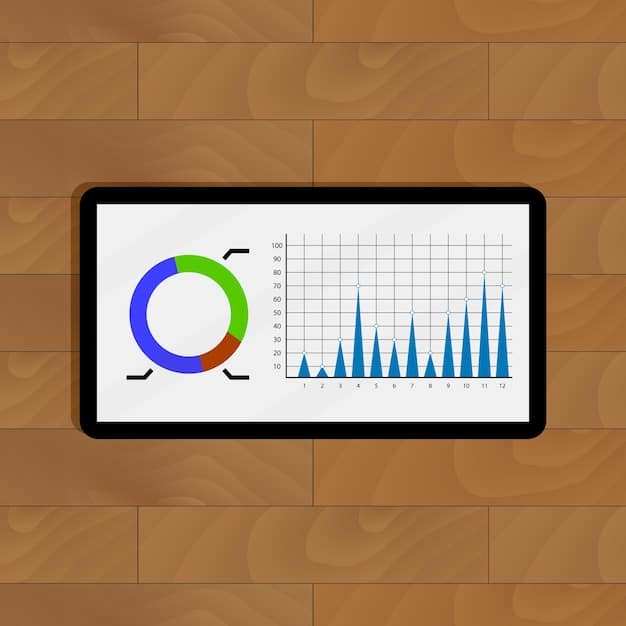Measure Customer Satisfaction Effectively: Key Metrics & Tools for 2025

Measuring customer satisfaction effectively in 2025 involves utilizing key metrics like Net Promoter Score (NPS), Customer Satisfaction Score (CSAT), and Customer Effort Score (CES), alongside advanced tools such as AI-powered analytics and personalized feedback platforms to gain actionable insights and enhance customer experience.
Want to ensure your business thrives in 2025? Understanding **how to measure customer satisfaction effectively** is more crucial than ever. With evolving technology and rising customer expectations, leveraging the right metrics and tools will be essential for staying competitive and building lasting customer relationships.
Why Measuring Customer Satisfaction Matters in 2025
In an increasingly customer-centric business landscape, measuring customer satisfaction isn’t just a good practice—it’s a necessity. But why does it matter so much, especially as we look ahead to 2025?
Understanding your customers’ feelings and experiences will be critical for driving loyalty, improving your products and services, and ultimately, achieving sustainable growth.
The Evolving Customer Landscape
Customer expectations are constantly rising. What was considered exceptional service yesterday might be the bare minimum today. Staying ahead requires continuous monitoring and adaptation.
- Personalization is Key: Customers expect tailored experiences that cater to their individual needs and preferences.
- Seamless Omnichannel Experience: They demand consistency and convenience across all touchpoints, whether online, in-store, or via customer service.
- Proactive Support: Customers appreciate businesses that anticipate their needs and offer solutions before problems arise.
The Impact on Business Outcomes
Measuring and acting on customer satisfaction data has a direct impact on various business outcomes. It’s not just about feeling good; it’s about improving your bottom line.
High satisfaction leads to increased customer retention, positive word-of-mouth referrals, and a stronger brand reputation. All of these contribute to long-term profitability and success.
In conclusion, effectively understanding and measuring customer satisfaction is quintessential for fostering strong business relationships and optimizing business outcomes, especially when you consider market forecasts for 2025.
Key Customer Satisfaction Metrics for 2025
To truly understand how your customers feel, you need to track the right metrics. While the specific metrics you choose will depend on your business and industry, some are universally valuable. What are the key customer satisfaction metrics you should prioritize in 2025?
Let’s explore the most important metrics you should be tracking and how they can provide valuable insights into your customer experience.

Net Promoter Score (NPS)
NPS measures customer loyalty by asking a simple question: “How likely are you to recommend our company/product/service to a friend or colleague?”
Customers respond on a scale of 0 to 10, and are then categorized into Promoters (9-10), Passives (7-8), and Detractors (0-6). Your NPS is calculated by subtracting the percentage of Detractors from the percentage of Promoters.
- Provides a Holistic View: NPS gives you a broad understanding of overall customer sentiment.
- Easy to Track and Benchmark: It’s simple to implement and compare against industry benchmarks.
- Actionable Insights: Analyzing NPS scores can reveal areas where you excel and areas that need improvement.
Customer Satisfaction Score (CSAT)
CSAT measures customer satisfaction with a specific interaction or experience. It typically asks customers to rate their satisfaction on a scale of 1 to 5, ranging from “Very Unsatisfied” to “Very Satisfied.”
CSAT surveys are often used immediately after a customer service interaction, a product purchase, or any other key touchpoint. This allows you to gauge customer satisfaction in real time.
- Specific and Targeted: CSAT provides focused feedback on individual experiences.
- Real-Time Insights: You can quickly identify and address issues as they arise.
- Actionable Feedback: CSAT responses often include open-ended comments, offering valuable qualitative insights.
Customer Effort Score (CES)
CES measures the effort a customer has to expend to interact with your company. It typically asks customers to rate their agreement with a statement like “The company made it easy for me to handle my issue.”
CES responses are usually collected on a scale of 1 to 7, with lower scores indicating less effort required. A lower CES score generally correlates with higher customer satisfaction and loyalty.
- Focuses on Ease of Experience: CES helps you identify friction points in the customer journey.
- Predictive of Loyalty: Customers are more likely to remain loyal to companies that are easy to do business with.
- Actionable Improvements: Reducing customer effort can lead to significant improvements in satisfaction and retention.
Measuring these key metrics provides a comprehensive view of customer sentiment, which also allows you to make informed decisions about improving customer experience.
Advanced Tools for Measuring Customer Satisfaction in 2025
The tools you use to measure customer satisfaction can be just as important as the metrics themselves. In 2025, expect to see even greater reliance on advanced technologies that automate data collection, analyze feedback in real time, and provide personalized insights. What are these advanced tools?
Here are some of the tools that will be essential for effectively measuring customer satisfaction in the coming years:
AI-Powered Analytics Platforms
Artificial intelligence (AI) is revolutionizing the way businesses analyze customer data. AI-powered analytics platforms can automatically process vast amounts of structured and unstructured data to identify patterns, trends, and insights.
These platforms can analyze customer reviews, social media posts, and customer service interactions to understand customer sentiment and identify areas for improvement.
- Automated Data Analysis: AI platforms can quickly analyze large datasets, saving time and resources.
- Sentiment Analysis: AI can accurately gauge customer sentiment from text data, providing valuable qualitative insights.
- Predictive Analytics: AI can predict future customer behavior based on historical data, enabling proactive interventions.

Personalized Feedback Platforms
Generic surveys are becoming less effective as customers expect personalized experiences. Personalized feedback platforms use data to tailor questions and survey formats to individual customers.
These platforms can adapt to customer behavior, preferences, and past interactions to deliver more relevant and engaging surveys, leading to higher response rates and more accurate data.
- Tailored Surveys: Personalized surveys are more engaging and likely to elicit thoughtful responses.
- Adaptive Questioning: Platforms can adjust questions based on previous responses, diving deeper into specific issues.
- Improved Response Rates: Customers are more likely to participate in surveys that feel relevant to their experiences.
Real-Time Feedback Systems
Waiting days or weeks to collect and analyze customer feedback is no longer sufficient. Real-time feedback systems allow you to capture and respond to customer sentiment as it happens.
These systems often use in-app surveys, chatbots, and instant messaging to gather feedback immediately after a customer interaction, providing immediate insights and opportunities for intervention.
- Immediate Insights: Real-time feedback allows you to address issues as they arise.
- Proactive Intervention: You can offer immediate assistance to dissatisfied customers, potentially turning a negative experience into a positive one.
- Continuous Improvement: Real-time data enables continuous monitoring and optimization of the customer journey.
By leveraging these advanced tools, businesses can gain a deeper, more accurate understanding of customer satisfaction and use that information to drive meaningful improvements.
Best Practices for Implementing a Customer Satisfaction Measurement Program
Implementing a customer satisfaction measurement program is not just about collecting data; it’s about using that data to drive meaningful change. To ensure your program is effective, follow these best practices.
Let’s explore some critical actions for putting a customer satisfaction program into action, guaranteeing that you get useful, actionable insights from your hard work.
Define Clear Objectives
Before you start collecting data, define clear objectives for your measurement program. What do you want to achieve? What specific questions do you want to answer?
Having clear objectives will help you focus your efforts, choose the right metrics, and ensure that your program delivers valuable insights.
Without clear objectives, you risk collecting data that is irrelevant or difficult to interpret. This can lead to wasted time and resources.
Choose the Right Channels
The channels you use to collect customer feedback can significantly impact your response rates and the quality of your data. Choose channels that align with your target audience and the type of feedback you’re seeking.
Consider using a combination of channels, such as email surveys, in-app surveys, social media monitoring, and customer service feedback forms.
What combination will provide the breadth and precision of response that you need? Think about your different touchpoints with a customer and when you might learn the most.
Act on the Data
Collecting customer satisfaction data is only half the battle. The real value comes from acting on the data and implementing changes based on customer feedback.
Share your findings with relevant teams, prioritize areas for improvement, and track the impact of your changes on customer satisfaction metrics.
- Close the Loop: Follow up with customers who provided negative feedback to address their concerns and show that you value their input.
- Empower Employees: Give employees the autonomy to resolve customer issues and make decisions that improve the customer experience.
- Continuous Improvement: Make customer satisfaction a continuous focus, regularly reviewing data and implementing changes to optimize the customer journey.
By following these best practices, businesses can build a culture of customer centricity and drive long-term success.
Overcoming Challenges in Customer Satisfaction Measurement
Measuring customer satisfaction is not always easy. Businesses often encounter challenges that can undermine the accuracy and effectiveness of their measurement programs. What are some common hurdles and strategies to address them?
Let’s explore solutions to some widespread challenges you may face with your customer satisfaction program.
Low Response Rates
One of the biggest challenges in customer satisfaction measurement is low response rates. Customers are often reluctant to participate in surveys or provide feedback, especially if they’re busy or have had a negative experience.
To improve response rates, make surveys short, easy to complete, and mobile-friendly. Offer incentives for participation, such as discounts or gift cards. And personalize your invitations to make them more engaging.
Bias in Feedback
Customer feedback is often biased, with customers who have had either very positive or very negative experiences being more likely to provide feedback. This can skew your data and make it difficult to get an accurate understanding of overall customer satisfaction.
To mitigate bias, use a variety of data sources, including both survey data and observational data. Monitor social media, customer reviews, and customer service interactions to get a more complete picture of customer sentiment.
Another step you could take is to make sure all opinions are valued and heard. This can be done through direct surveying or anonymous feedback opportunities.
Data Silos
Customer satisfaction data is often stored in different systems and departments, making it difficult to get a holistic view of the customer experience. Data silos can prevent you from identifying trends, patterns, and root causes of customer satisfaction issues.
To overcome data silos, integrate your customer satisfaction data with other business systems, such as your CRM, marketing automation platform, and customer service software. Use data visualization tools to create dashboards that provide a unified view of customer data.
By proactively addressing these challenges, businesses can improve the accuracy, reliability, and effectiveness of their customer satisfaction measurement programs.
The Future of Customer Satisfaction: Trends to Watch in 2025
The field of customer satisfaction measurement is constantly evolving. As we look ahead to 2025, several key trends are poised to shape the future of how businesses understand and improve customer experience. What are these future trends?
Staying on top of these trends will be essential for staying competitive and building lasting customer relationships.
Increased Focus on Proactive Measurement
Rather than waiting for customers to provide feedback, businesses will increasingly focus on proactive measurement techniques. This includes using AI to monitor customer behavior, identify potential issues, and intervene before they escalate.
Proactive measurement allows you to anticipate customer needs, resolve issues before they impact satisfaction, and build stronger relationships.
Integration of Customer Satisfaction with Employee Satisfaction
Businesses are recognizing the strong connection between customer satisfaction and employee satisfaction. Happy employees are more likely to deliver exceptional customer service, leading to higher customer satisfaction.
In 2025, expect to see more companies integrating customer satisfaction measurement with employee satisfaction programs, creating a virtuous cycle of positive experiences.
Prioritizing the well-being of your team can indirectly impact customer care. Well-trained employees that feel valued are more likely to treat customers with extra attention and dedication.
Emphasis on Personalization at Scale
Personalization is already a key trend in customer experience, but in 2025, businesses will need to deliver personalized experiences at scale. This requires leveraging data, AI, and automation to tailor interactions to individual customer needs and preferences.
Personalization at scale allows you to create more engaging and relevant experiences, leading to higher customer satisfaction and loyalty.
Predictive AI, tailored surveys, and even in-person interactions are all avenues to consider as you personalize your system and approach.
| Key Point | Brief Description |
|---|---|
| 📊 NPS | Measures customer loyalty and likelihood to recommend your brand. |
| ⭐ CSAT | Gauges satisfaction with specific interactions or touchpoints. |
| ⏱️ CES | Evaluates the effort required to interact with your company. |
| 🤖 AI Analytics | Automates data analysis, sentiment detection, and predicting behaviours. |
FAQ
▼
Measuring customer satisfaction helps identify areas of improvement, increases customer loyalty and retention, and enhances brand reputation, ultimately driving revenue growth.
▼
NPS measures customer loyalty, CSAT measures satisfaction with specific interactions, and CES measures the effort required by customers to interact with your company.
▼
AI tools automate data analysis, provide sentiment detection from text, personalize feedback, and predict customer behavior, leading to more accurate insights.
▼
Best channels include email surveys, in-app surveys, social media monitoring, and customer service feedback forms, chosen based on your target audience and feedback type.
▼
Regularly measure customer satisfaction, integrating real-time feedback systems for quick responses and continuous improvement of the customer journey.
Conclusion
Measuring customer satisfaction effectively in 2025 demands a strategic approach, combining key metrics like NPS, CSAT, and CES with advanced AI-driven tools. By prioritizing proactive measurement, integrating customer and employee satisfaction, and emphasizing personalized experiences, businesses can foster lasting customer loyalty and drive sustainable growth in a rapidly evolving market.





